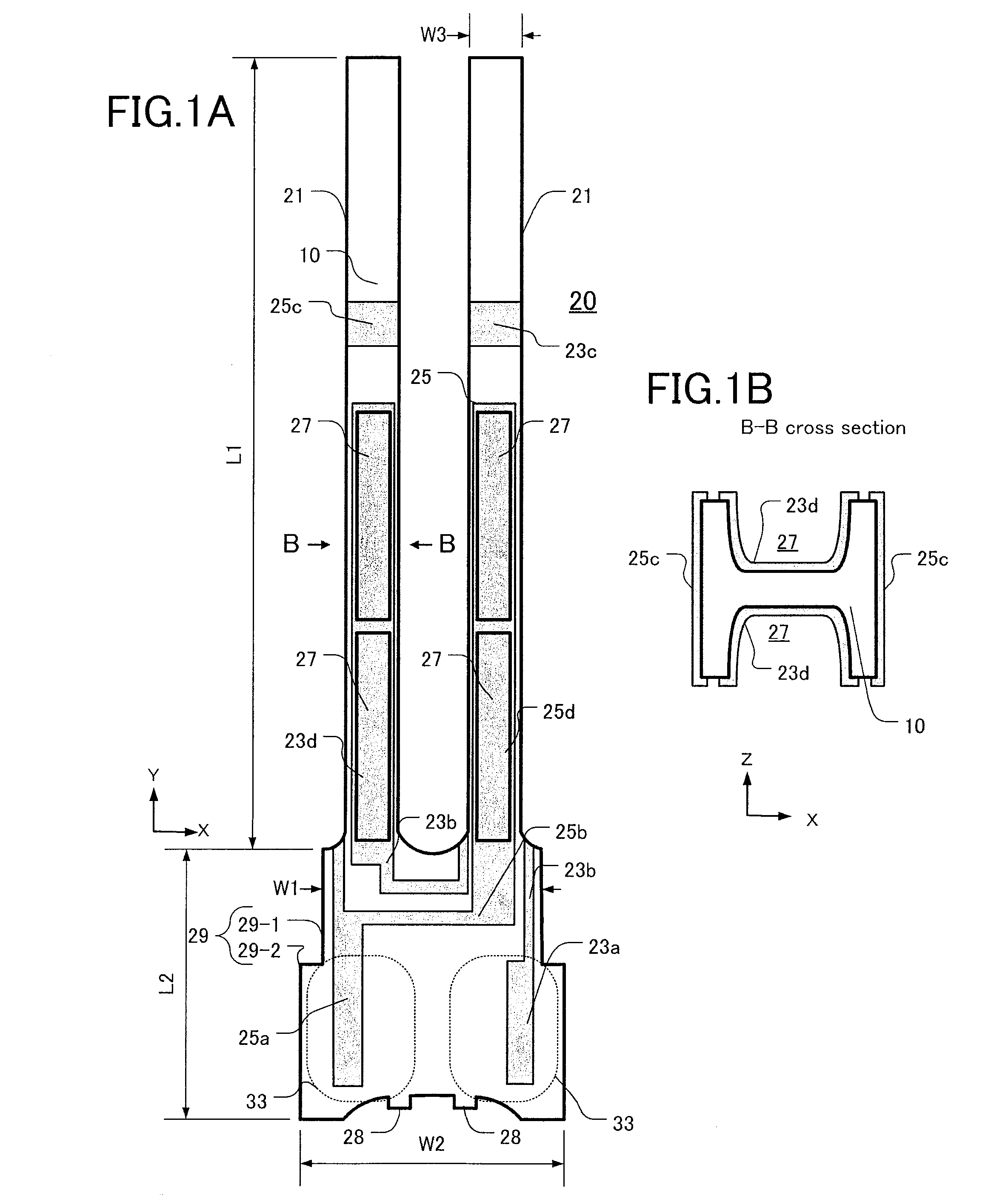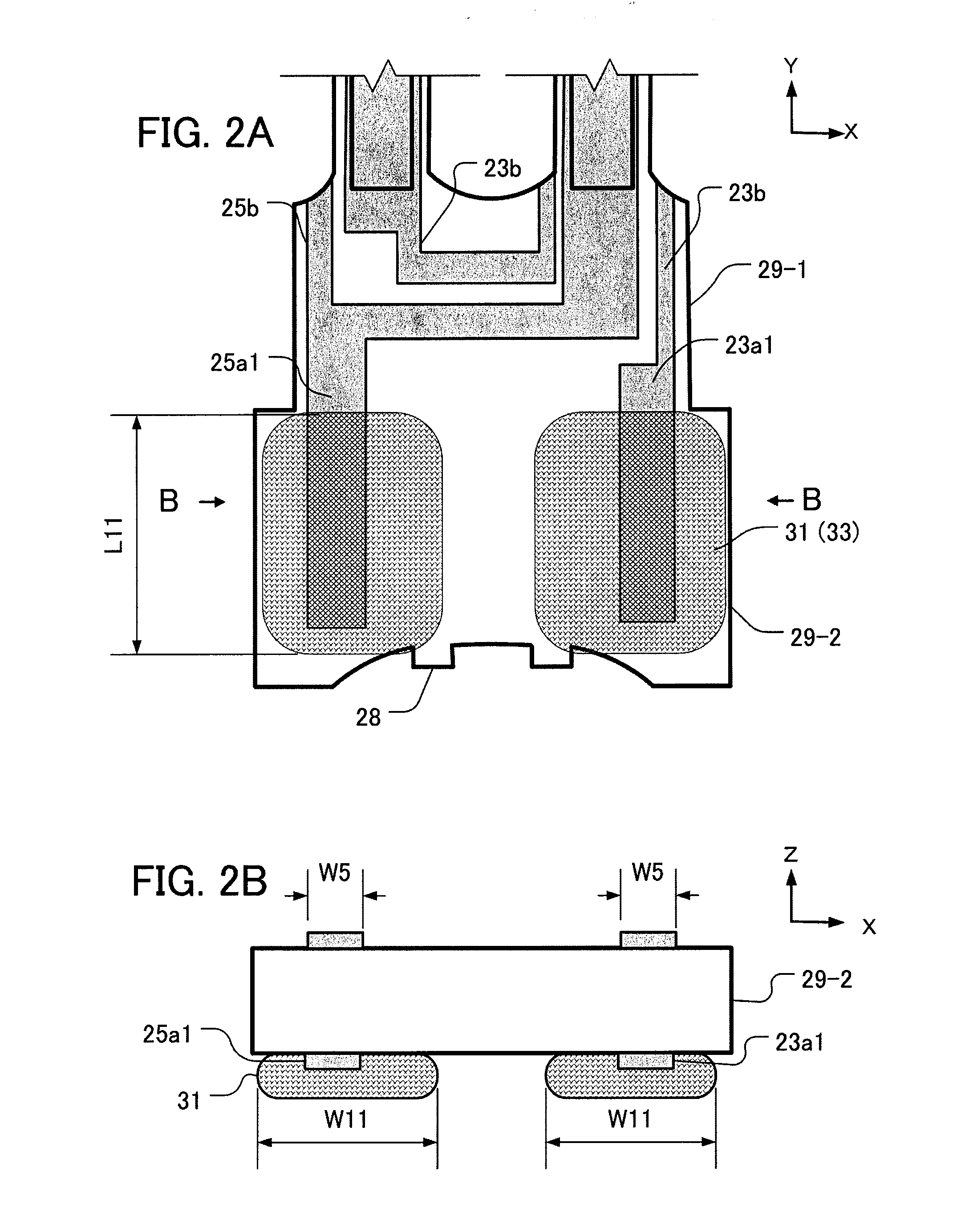Piezoelectric vibrating pieces and piezoelectric devices
a piezoelectric and vibrating piece technology, applied in piezoelectric/electrostrictive/magnetostrictive devices, piezoelectric/electrostriction/magnetostriction machines, electrical apparatus, etc., can solve the problem of not improving the variability of ci value, and achieve the effect of small area to be conducted with electrically conductive adhesives
- Summary
- Abstract
- Description
- Claims
- Application Information
AI Technical Summary
Benefits of technology
Problems solved by technology
Method used
Image
Examples
fourth embodiment
[0049]A first base electrode 23a4 and second base electrode 25a4 formed on the second base portion 29-2 of a fourth embodiment is a L-shape and the width of electrode is 0.01 mm to 0.10 mm. In FIG. 5B, the area where the electrically conductive adhesive 31 conducts to the first base electrode 23a4 and the second base electrode 25a4 is about 10%. Such first base electrode 23a4 and second base electrode 25a4 have low CI value variability and the ZCT variability becomes low.
[0050]FIGS. 6A-6B are enlarged views of the second base portion 29-2 of a fifth embodiment. FIG. 6A shows a back surface (the surface to be adhered) of the second base portion 29-2, FIG. 6B is a front surface, and FIG. 6C is a cross-sectional view taken from C-C line of FIG. 6B. On the second base portion 29-2 of a sixth embodiment, the shapes of base electrodes on the front and back surface are different. As FIG. 6A shows, the first base electrode 23a1 and the second base electrode 25a1 are as same shapes as of the...
first embodiment
[0051]As shown in FIG. 6C, the conduct of the electrically conductive adhesive 31 and the first base electrode 23a1 and the second base electrode 25a1 is the same as the first embodiment, so the CI value variability and ZCT variability become lower.
[0052]FIGS. 7A-7B are enlarged views of the second base portion 29-2 of a sixth embodiment. FIG. 7A is a back surface of the second base portion 29-2 and FIG. 7B is a cross sectional view taken from B-B line of FIG. 7A. The first base electrode 23a5 and the second base electrode 25a5 are base electrodes having large dimension as previous electrode have. If the electrically conductive adhesive 31 is applied to the electrodes with this condition, the variability of CI value and ZTC become wide. Therefore, an insulating layer 37 is coated at least on the back surface of the first base electrode 23a5 and the second base electrode 25a5 where the electrically conductive adhesive 31 is applied. The insulating layer 37 is preferably made of oxide...
third embodiment
[0058]If the conducting area is more than 1%, the tuning-fork type crystal vibration piece 20 can be actually excited, so the minimum limit of dimension ratio of the base electrode corresponding the electrically conductive adhesive 31 is 1%. On the contrary, if the dimension ratio of the base electrode corresponding the electrically conductive adhesive 31 is more than 80%, especially the variability of ZCT of the third embodiment becomes 1.0 and the difference becomes smaller compared to the previous base electrode. So, the maximum limit of dimension ratio of the base electrode corresponding the electrically conductive adhesive 31 is 80%. As is shown by FIGS. 8B and 8C, 5% to 50% of the dimension ratio of the base electrode corresponding the electrically conductive adhesive 31 is preferable.
[0059]FIG. 9 is a plan view showing an embodiment of the second tuning-fork type crystal vibrating piece 120. The same components of configuration use the same numbers used in FIG. 1A and others....
PUM
 Login to View More
Login to View More Abstract
Description
Claims
Application Information
 Login to View More
Login to View More - R&D
- Intellectual Property
- Life Sciences
- Materials
- Tech Scout
- Unparalleled Data Quality
- Higher Quality Content
- 60% Fewer Hallucinations
Browse by: Latest US Patents, China's latest patents, Technical Efficacy Thesaurus, Application Domain, Technology Topic, Popular Technical Reports.
© 2025 PatSnap. All rights reserved.Legal|Privacy policy|Modern Slavery Act Transparency Statement|Sitemap|About US| Contact US: help@patsnap.com



